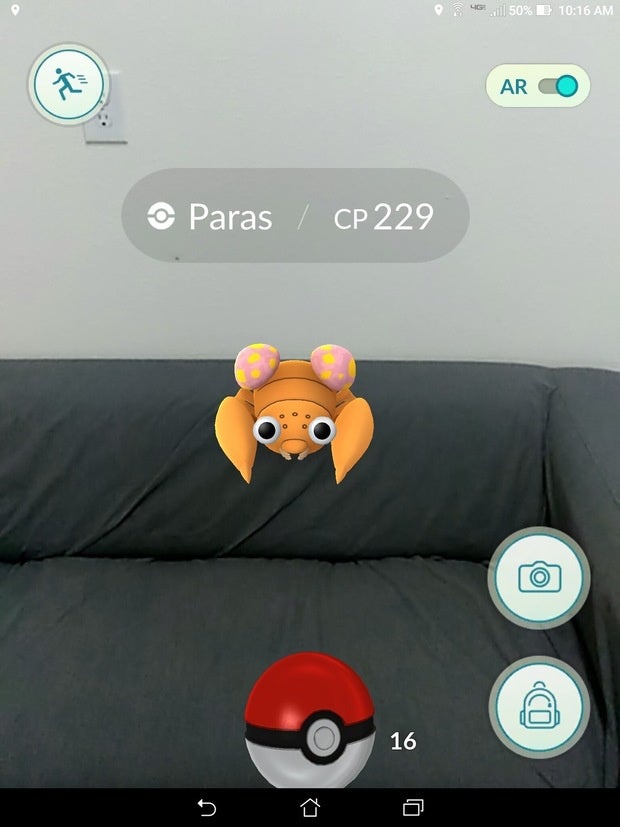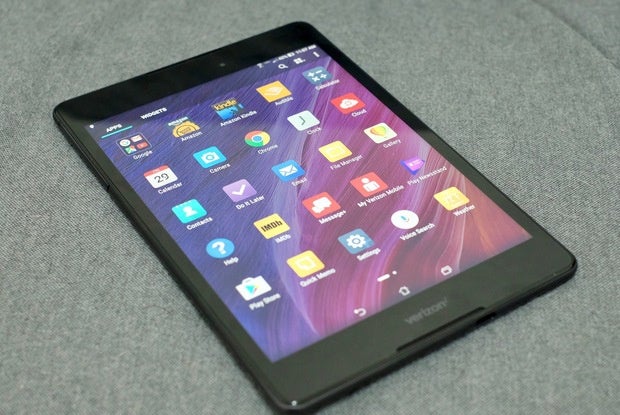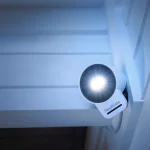If you couldn’t tell by looking at the front of the the Asus Zend Z8, Verizon reless has placed its exclusive claim to this tablet. Verizon sure loves putting its logo in places it’s hard to miss, like directly underneath the display.
Forgoing overzealous logo placement, the Asus Zend Z8 carries a full retail price of $250 carries a spec sheet that puts it in line with most mid-range Android tablets. After using a review sample for about a week, I’ve come to the conclusion the Z8 is a tablet I wouldn’t mind using on a daily basis.
Familiar, yet different

The Z8’s power volume buttons have a clicky feel to them. The good kind of “click,” that is.
Maybe it’s just me, but in some regards the Z8 reminds me of the Nexus 7. Indeed, it’s different in many ways, but the look feel of the bezel plastic housing are what do it for me. Then again, it’s possible I’m feeling a tad nostalgic while holding an AS tablet (the company made the Nexus 7).
en holding the Z8 in portrait orientation, you’ll find the power volume buttons on the right side of the display. To the left of the display is where you’ll find the SIM card microSD card slots. A 3.5mm audio jack is found on top, while a B Type-C port is found on the bottom.
Surprisingly smooth for the price

th AR mode left active, the Zend Z8 hled the workload fairly well.
wering the Zend Z8 is Qualcomm’s Snapdragon 650 processor with 2 GB of RAM.
th kemon Go taking over the world, it only makes sense for the first performance test on any new device include tossing some keBalls. Using AR mode in kemon Go pushes performance limits of even the fastest devices currently available.
Indeed, the Zend Z8 slowed down when catching some kemon in AR mode, but it wasn’t enough to make the game unplayable. That honor goes to the Moto G4 G4 us, in my experience.
Outside of trying to catch ‘em all, overall performance on the Zend Z8 is a bit slower than using, say, the xel C, but that’s expected due to the contrast in processing power. Slower performance was most notable during tasks ranging from launching apps to opening multiple tabs in Chrome. Everything seemed to take just a bit longer.
To be clear, it’s not a drastic performance hit. But if you’re switching from a high-end tablet to the Zend Z8, you’re going to notice a difference.
For a $250 tablet, the Z8 is capable of the daily tasks we’ve come to expect: checking email, web browsing, checking Facebook, , for some, playing Minecraft.
Verizon only offers a 16GB variant or the Z8, with microSD support for adding up to 128GB of extra storage. Out of the box you’ll have 8.83GB of usable space, practically making a microSD card a requirement.
Battery life software improvements

The Z8’s lock screen provides current weather app shortcuts in addition to app notifications.
The Z8 runs Android 6.0.1, with Asus’s proprietary interface “ZenUI.” One of the added benefits ZenUI is ZenMotion. en enabled, you can use a series of gestures on the lock screen to launch apps or lock unlock the device. For example, you can draw a “C” with your finger to launch the camera app, while “Z” unlocks the tablet launches Chrome. You can customize the app each of the six different letters will open.
You can also double-tap to wake the device, or turn the lock screen off after reading notifications or checking the time. I didn’t find the letter shortcuts terribly useful, but I imagine after more time with the Z8 further customizing the functionality its usefulness would grow on me. I did, however, frequently wake the device with a quick double-tap to check the time or look at new Gmail alerts.
As for battery life, the Z8 does an excellent job of conserving power when in stby mode thanks to power management settings you can tweak to fit your needs. There are five different battery mode settings: rformance, Normal, wer Saving, Super Saving, Customized. Each one adjusts settings like brightness, C performance, network connections to squeeze as much battery life as possible out of each charge.
aving the Z8 unplugged overnight with the default wer Saving setting enabled would drop the battery only a couple percentage points. As long as you’re not binging on “Stranger Things,” the battery should get you through an full day of use.
Asus is proud of its display tech

The display really shines when watching movies or playing games.
And you know what? It should be.
en I first read the laundry list of marketing terms attached to the Z8, I was skeptical. Terms such as Tru2fe, TruVivid, VisualMaster are typical marketing fluff, all over the AS website, rarely mean anything to the user at the end of the day.
However, after watching a movie streaming a few YouTube videos I am impressed with the Z8’s display. eting terms aside, streaming an HD movie through the ay Store was crisp vivid, with colors not overly saturated. Dare I say, there was a true to life feel to the video.
For those keeping track at home, the Z8 boasts a 7.9-inch 2048×1536 I display.
A respectable tablet, but only at full price
I’ve always thought it’s a bit foolish to sign a two-year contract with a wireless carrier for a tablet. Sure, maybe the carrier knocks a couple hundred dollars off the purchase price, but at the end of the contract the cost of monthly service fee winds up being far more expensive than what you save.
Use the Asus Zend Z8 as an example: Full retail price is $250, or you can sign to a two-year term to drop the price by $100, with a the lowest monthly data plan running $30 per month.
ed, the monthly cost isn’t big of a factor if you plan on using its wireless capabilities on a regular basis. But at the end of the day, you’re better off paying the extra $100 upfront then going month-to-month for the data plan.
For someone shopping on a budget insistent on getting a tablet from Verizon reless spending $250 on the contract-free version of the Zend Z8 isn’t the worst decision you could make.

















